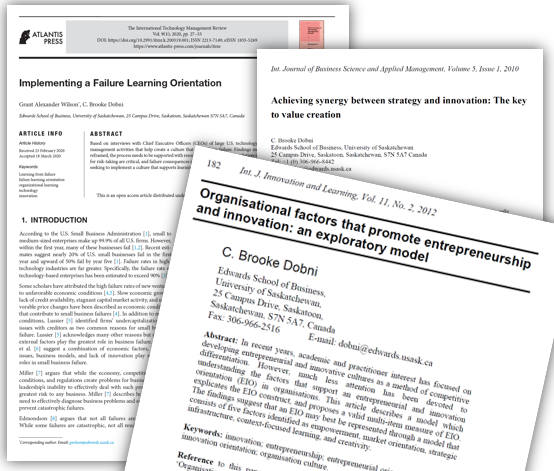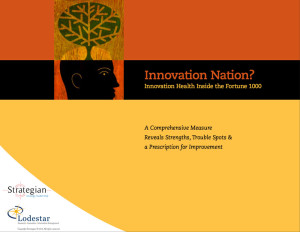What Does the Innovation Research Tell Us?
Innovation research tells us that innovation can be measured and strong cultures of innovation lead to the creation of sustainable competitive advantage and higher financial performance.
The key to innovation in organizations, according to research, resides in the ability to define, instill, and reinforce an innovation vision, culture, and capability among your employees and your external ecosystem.
Innovation flourishes in dynamic, collaborative cultures lead by leaders who articulate a strategic vision for innovation, and invest in it. The investment includes putting in place the training, systems and processes for ideation and knowledge management, and organizational processes to successfully commercialize the best ideas.
Through over 20 years of research and the publication of over 25 peer-reviewed academic articles on innovation and business strategy, InnovationOne®, LLC, founder, C. Brooke Dobni, PhD., has developed the InnovationOne Culture Index©, the most robust, quantitative diagnostic tool to assess, measure and benchmark organizational innovative culture and capability across the four organizational dimensions and 12 drivers of innovation. The InnovationOne Culture Index© has been benchmarked with over 3,000 organizations and is referenced to as one of the most comprehensive and reliable measures of innovation culture in organizations.
founder, C. Brooke Dobni, PhD., has developed the InnovationOne Culture Index©, the most robust, quantitative diagnostic tool to assess, measure and benchmark organizational innovative culture and capability across the four organizational dimensions and 12 drivers of innovation. The InnovationOne Culture Index© has been benchmarked with over 3,000 organizations and is referenced to as one of the most comprehensive and reliable measures of innovation culture in organizations.
In 2013, we published Innovation Nation? Innovation Health Inside the Fortune 1000, which was the largest study of innovation in the Fortune 1000 companies. It offered several new insights on a scientifically rigorous survey of 1,127 executives and senior managers, including:
- Impediments to achieving higher levels of innovation lie within organizational design and
 execution frameworks, including the lack of an explicit innovation strategy, and not a lack of creativity or empowerment at the employee level.
execution frameworks, including the lack of an explicit innovation strategy, and not a lack of creativity or empowerment at the employee level.
- How respondents rate their companies’ overall business performance relative to their competition is strongly correlated with innovation performance.
Through our research and consulting, we have also uncovered the seven traits of highly innovative companies. Companies, that rush to improve their innovation, often depending on a “silver bullet” solution or the investment in a new digital technology, fail because the make the mistake of not adhering to these six traits.
In addition to Innovation Nation?, Dr. Dobni has published numerous leading-edge articles and research papers on strategy and innovation in professional journals such as: The Strategic Management Journal; Journal of Business Strategy; European Journal of Innovation Management; Journal of Marketing Management; Marketing Intelligence and Planning; International Journal of Innovation Management; International Journal and Learning; International Journal of Business Science, among others.
In 2017, The Conference Board and InnovationOne partnered to launch the “Insights from Highly Innovative Companies: Results from The Conference Board and InnovationOne Global State of Innovation Survey 2017.” Our purpose was to uncover the methodologies, technologies, and practices successful innovators are currently using to innovate–and which ones provide the most advantage in today’s business climate.
The five insights form highly innovative companies are as follows. These companies:
- think of innovation as a strategic imperative for the whole enterprise–not just belonging in the R&D department.
- report more use of all available innovative methodologies and technologies than lagging innovators.
- have developed transparent and collaborative cultures of innovation–and this one of the biggest factors distinguishing them from low innovators by a margin of nearly 2 to 1.
- use metrics to measure innovation.
- report the most advantage from understanding the customer experience and developing as strong culture of innovation.
We continued our partnership with The Conference Board (and added the Japanese Productivity Center) in 2019 to provide more clarity on the useful and emerging practices of highly innovative global organizations and to uncover thier methodologies, technologies, and habits for being innovative. The result was the report, Useful and Emerging Practices of Highly Innovative Organizations in the Digital Era.
Our results reveal that high innovators distinguish themselves in multiple ways. They:
- Treat innovation as a strategic imperative
- Emphasize nurturing collaborative and transparent culture of innovation
- Involve external partners in their innovation strategies
- Use metrics to measure progress
- Invest in holistic, long-term innovation programs that
are aligned and integrated with the business strategy, but are also agile, capable, and well-
positioned to take advantage of short-term opportunities - Experiment using physical and virtual prototypes
- Invest in and set themselves up for successful digital transformation
- Report success with using prototypes, developing solid cultures of innovation, Agile methodologies, design thinking, and stage gate.
Dr. Dobni holds a Ph.D. in Strategy from the University of Bradford, Bradford-Leeds, UK, and an MBA and Bachelor of Commerce degrees from the University of Saskatchewan. He can be reached at [email protected].



Sign up for our InnovationOne Newsletter to receive a free copy of one of our valuable reports:
-
Innovation Nation? Insights on the Innovation Health of the Fortune 1000
-
Insights from Highly Innovative Companies: Results from The Conference Board and InnovationOne Global State of Innovation Survey 2017
-
Useful and Emerging Practices of HIghly Innovative Organizatoins in the Digital Eera, 2019. To order Useful and Emereging Practices of Highly Innovative Organizations, 2019, Click HERE.
Peer Reviewed and Published Articles on Innovation
Below are 25 abstracts of Dr. Dobni’s publications in peer-reviewed academic and professional journals, which can be ordered by the publication or through an online service, such as ReadCube. Please click on any abstract to learn more.
